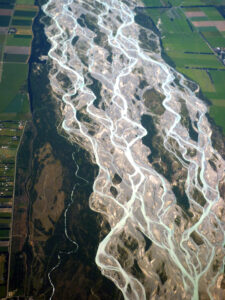
A braided stream is a stream that consists of multiple small, shallow channels and is divided and recombined numerous times forming a pattern resembling the strands of a braid.
A braided stream is a type of river or waterway characterized by a network of interwoven channels separated by small and often temporary islands or bars made of sediment such as sand, gravel, and pebbles. These channels frequently split and rejoin, creating a braided appearance similar to strands of hair or rope.
Several factors contribute to the formation of braided streams:
- High Sediment Load: Braided streams typically occur in areas where there is a high supply of sediment, such as mountainous regions, glaciers, or areas with erodible rock formations. The abundance of sediment leads to frequent deposition and erosion, shaping the network of channels.
- Variable Flow Rates: Fluctuations in water flow can also contribute to braiding. During periods of high discharge, such as heavy rainfall or snowmelt, the river carries more sediment and can erode its banks, creating new channels. During low flow periods, some of these channels may become inactive or dry up.
- Shallow Gradient: Braided streams often form in areas with a relatively shallow slope or gradient. This allows the water to slow down and deposit sediment, leading to the development of multiple channels.
- Vegetation and Obstacles: The presence of vegetation, debris, or other obstacles in the river can also influence channel patterns. Vegetation can stabilize banks and reduce erosion, while large debris can create barriers that cause the water to split into multiple channels.
Braided streams are dynamic systems, constantly changing their channels, bars, and islands in response to variations in flow, sediment supply, and other environmental factors. They are important ecological habitats and play a role in sediment transport, river morphology, and floodplain dynamics.
« Back to Glossary Index